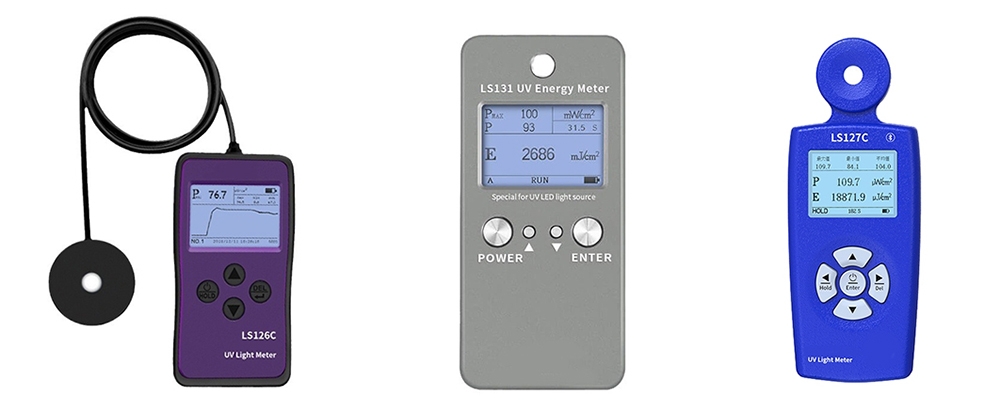A UV meter is a tool for measuring the intensity of ultraviolet light. The working principle of the UV light meter is to use ultraviolet sensors to measure the intensity of ultraviolet light. When using the UV light intensity meter, you need to aim the sensor at the ultraviolet source, and then observe the value on the instrument display to get the measurement result of the ultraviolet intensity.
Why choose a UV meter?
The UV meter, also known as the ultraviolet light meter, consists of a UV probe UV365 (or UV420) and a reading unit, and the two parts are connected by a cable with a plug and a socket. The ultraviolet intensity meter is a device for measuring the intensity of ultraviolet light. Ultraviolet light is light with a very short wavelength and is invisible to the human eye. Generally speaking, light from 10nm to 400nm belongs to the ultraviolet range. Ultraviolet light does not only bring harm to the human body but also plays an irreplaceable role in sterilization. Some ultraviolet rays can detect skin spots and provide treatment suggestions for skin diseases and anti-aging. Ultraviolet rays can also treat wounds, slowing down cell proliferation through direct influence, thereby promoting wound recovery. Through the detection of ultraviolet rays, we can also make better improvements in human sun protection. With the ultraviolet intensity detector, we can better understand the intensity of ultraviolet rays.
On the other hand, DNA has absorption bands under specific wavelengths of ultraviolet light. When DNA absorbs ultraviolet light, it becomes damaged and harmful to the human body. It also has various other effects that make it an extremely important light source for industrial purposes. Therefore, it is very important to measure UV light, and a UV intensity meter is needed to measure the intensity. Choosing the right UV meter is very important for different application scenarios, whether it is UV intensity monitoring in outdoor activities or controlling UV light sources in industry and laboratories. The following are several key factors that should be considered when choosing a high-performance UV meter.

How to choose a UV meter?
- UV wavelength range: First, you need to determine what type of UV radiation you want to measure. UV radiation is divided into three categories based on wavelength: UV-A (315-400 nm): commonly used in tanning equipment, UV curing, etc; UV-B (280-315 nm): suitable for sun exposure monitoring, skin testing, etc; UV-C (100-280 nm): mainly used in disinfection and sterilization processes. Make sure the UV radiometer you choose can measure the required band range to meet your specific application needs.
- Measurement accuracy and sensitivity: Measurement accuracy is an important consideration when choosing a UV radiometer, especially in security or industrial applications where precise data is required. Check the error range or tolerance of the instrument to ensure that its accuracy meets your requirements. Instruments with high sensitivity can capture weak UV radiation more accurately.
- Display function: Choose a UV radiometer with a clear, easy-to-read display. LCD or OLED displays with backlight functions are especially useful in low-light environments. Some models also offer graphical displays or additional data, such as cumulative exposure time, to help users view more comprehensive measurement information.
- Measurement range: Choose the right measurement range for your needs. If you need to measure low-intensity UV radiation (such as indoors or on cloudy days), make sure the instrument can accurately detect lower radiation levels. If you are dealing with high-intensity UV sources (such as UV disinfection equipment), you should choose an instrument that can handle high-intensity UV radiation and ensure that the equipment will not be damaged by high intensities.
- Portability: If you need to use the UV radiometer in different locations (such as outdoors, laboratories, or factories), choose a portable and lightweight model. Some models also come with a protective case for easy portability and increased durability.
- Power supply: UV radiometers can be powered by batteries or rechargeable systems. Choose the type of power supply that suits your frequency of use and convenience. For situations where you need to use it frequently, battery life is also a key consideration.
- Alarm prompt: If used for security monitoring, some radiometers have an automatic alarm function that will sound a prompt when UV radiation reaches a dangerous level.
- Durability: If you need to use it in a harsh environment (such as high temperature or outdoors), choose a UV radiometer with waterproof, dustproof and high-temperature resistance functions to ensure that the device can still work normally under harsh conditions.
According to the specific application requirements, consider the UV band, measurement accuracy, display function, portability and additional functions to choose the UV radiometer that best suits you. There are all kinds of test and measurement equipment and ultraviolet meters on sisco.com are offered, including UVA, UVB and UVC meters for selection, the measuring ranges from 230nm to 420 nm. Whether it is for personal protection, industrial use, or scientific research, choosing the right equipment can help you better monitor and control the impact of UV radiation.

